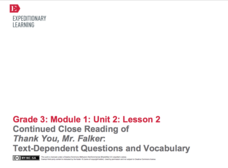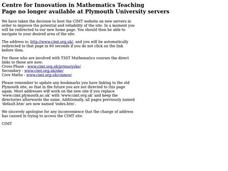Curated OER
Control the Classroom from Day One
Avoid the beginning-of-the-year scramble by having a strategy for the first few days of school.
Music Fun
Instruments to Trace Color and Label
Handbells and castanets. Triangles and timpani. Trumpets and trombones. As part of their study of instruments, young musicians label, trace and color the parts of seven instruments. Also included in the resource packet are tracing...
PHET
Planet Designer: Martian Makeover
Mars used to have liquid water, can you make it come back? Use the lesson plan and simulation to understand why Mars lost its magnetic field, why atmosphere is important, and what gravity has to do with it. This is the third...
MathMovesU
Practice: Measuring Angles and Using a Protractor and More!
Four fabulous worksheets are included in this resource, all having to do with the measurement of angles. On the first, anglers will use a protractor to determine the degrees of 10 different angles. An arc is drawn on each. On the second,...
Curated OER
Blood Vessels
A series of diagrams and photographs is a vivid tool for delivering a lesson about blood vessels. Each slide has notes for the lecturer to use to explain each slide. Your young biologists will increase their understanding of the...
Curated OER
Guess Who?
Your class is designing an online dating service, and they have to complete their members' profiles! Group your kids in pairs, and distribute this resource to get them speaking! As one partner describes a member, the other has to...
Curated OER
¿Tú o Usted?
In English, we only have one word that means you, but in Spanish, speakers can use either tú or usted. Print this sheet for your beginning speakers to introduce them to this idea. First, read through the information provided, and then...
Agriculture in the Classroom
Chocolate Taste-Testing: Introduction to Loco for Cocoa
Is the price of chocolate a good indicator of taste? Your learners will approach this question through experimentation and analysis, and will then delve into the rich history and complexity of cacao and chocolate.
Curated OER
Scapegoating and Othering
Scapegoating and "Othering" is the focus of a series of activities that ask groups to consider how these behaviors contribute to hatred and intolerance. Groups are given a scenario and discussion questions based on the situation. Whether...
Curated OER
The Achievements and Challenges of Egypt
Awesome, that is all I have to say! This set of lessons provides learners with an understanding of ancient Egyptian laws, lifestyle, religion, and culture. It engages them in a critical analysis activity regarding the film, "The Prince...
Forest Foundation
The Sustainable Forest
As part of their examination of forest ecosystems, class members examine how foresters, biologists, botanists, geologists, and hydrologists work to together to develop a management plan for sustainable forests.
National History Day
A Clever War: Scientific and Technological Advances in World War I
Technology—changing lives and transforming war. Your tech-loving historians examine photographs and primary documents to explore how technology changed not only World War I, but also how it moved society forward. They apply their...
Scholastic
Study Jams! Transformations
Flip, spin, and shift with this vocabulary-rich video on transformations. Learners watch different movements and see how to move an object without affecting its size. The video follows with a multiple choice assessment that...
Curated OER
Shakespearean Comedy on Film
This instructional activity will focus on the aspects of Shakespeare's comedy that become more evident in performance. By viewing clips of the same Shakespeare scene in different film versions, high schoolers have the opportunity to...
EngageNY
Continued Close Reading of Thank You, Mr. Falker: Text Dependent Questions and Vocabulary
In the second lesson plan in a series that revolves around the story, Thank You, Mr. Falker, learners practice the skill of answering direct questions from the text while using complete sentences. After a teacher-led review of how to...
Curated OER
Bog Child
You are destined for an engaged and happy class as they read Siobhan Dowd’s Bog Child because there is nothing missing from this study guide, seriously. This might be the easiest novel to teach because you don’t have to do a thing in...
Curated OER
Let's Play Outside!
Here are 14 games for you to bring to summer camp, a neighborhood gathering, or a birthday party!
Child Care Lounge
How Many Spots are on Each Ladybug?
The ever popular ladybug serves as a excellent tool for developing the number sense of young mathematicians on this math worksheet. Presented with a series of colorful pictures, children practice counting and writing the numbers 1-10 as...
Facing History and Ourselves
The Challenge of Confirmation Bias
Confirmation bias makes it difficult to overcome our preconceived notions of others. That's the big idea in a lesson that teaches learners strategies to recognize and question their biases.
Curated OER
Have You Seen My Duckling?
In this language arts instructional activity, students read a story called Have You Seen My Duckling? Students listen to the names of the places the duckling was hiding and identify the corresponding page numbers.
Curated OER
Using Addition and Subtraction to Solve Problems II
In this addition and subtraction problem solving instructional activity, 3rd graders use addition and subtraction skills to answer ten multiple choice word problems.
Curated OER
Enemies and Threats to Sea Horses
Learners research threats and enemies of the sea horse. In this animal biology lesson, students use the Internet to find threats and enemies of sea horses and write a paragraph on their findings.
Curated OER
The Phrasal Verbs of To Go Exercise
For this recognizing "to go" verbs worksheet, students match the phrasal verbs with their meanings and translate them, and then use them to fill in the blanks. Students write 31 answers.
Curated OER
Converting Fractions to Decimals
In this fractions and decimals activity, students learn to write fractions as decimals by first reading the instructions and examples. Students solve 20 problems. This is an online activity that can be done on paper.























